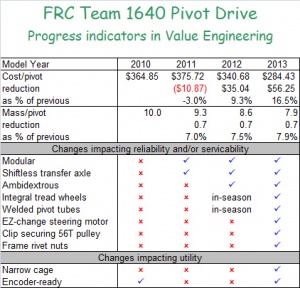DEWBOT X Drive Train
of Ultimate Ascent, the team decided on 11-January to utilize pivot drive again. In addition, to maximize agility, this drive would utilize our new Ocelot control code.
Contents
Issues with the 2013 pivot design
Our 2013 robot, DEWBOT IX, participated in more competitions, demos and driver practice than any robot before it (we said this last year, but it is true again this year). That said, the 2013 pivots performed extremely well, but the following issues were observed:
- One Pivot tube/Pivot Top weld failed in 2013 (in off-season competition), resulting in the total constructive loss of the pivot module. This failure rate is considered acceptable at this time
- One Igus bushing came loose from the module top plate. Repaired.
- Occasional loss of calibration was were not secure within the pivot tops and shifted over time. Small and mostly angular shifts resulted in loss of calibration. Large shifts caused pivot failure. This problem was resolved during the season by welding the pivot tubes to tops.
Value Engineering
Value engineering seeks to widen the gap between the value a product provides to the customer and its cost. Value and cost in this context includes both monetary and non-monetary measures. For example, addressing the issues listed above increases the value of the product to the customer (drive team & pit crew). Cost includes monetary cost (measured following FRC cost guidelines) but also mass, manpower and machine time.Each Autumn, we conduct a value engineering exercise on our pivot drive design to understand what changes we would make if we were to select pivot drive again. The results of this exercise are summarized in the accompanying Table.
Developments on the 2012 pivot design
Development of the 2013 pivot design took place through a number of physical tests and engineering exercises during the latter half of 2012.
The following design changes were made:
- Switched back to BaneBots RS-540 motor (legal again) in lieu of RS-395
- Replacing 35 chain with 25 chain - 9T & 24T sprockets replaced with 12T & 32T - 44 link 25 chain reduces pivot cage height
- Change wheel to AndyMark 4" HiGrip Wheel (am-2256) - 32T sprocket secured w/ 10-32 x 5/8" SHCSs - No sprocket spacers needed
- Adopted the VexPro 32T sprocket
- Replace top 1" ball bearing race with Igus polymer bushing
- Narrow pivot cage from 4" to 3.184" - machined acetal spacer eliminated - shorter axles
- Pivot tube designed to be welded into the pivot top
- Drive miter gear shortened axially by 0.25" - further reducing pivot cage height
- Elimination of (1) of (2) E-clips on the pivot tube
- Reduce spacer length between module plates to 1.75" (2" in 2011; 1.875" in 2012)
- Use Deaver steering motor attachment
- E-clip securing the 56T HTD5 pulley
- Reduce pivot mount points from (5) to (4) and replace locknuts with rivet nuts on frame
- 7075 Al replaced 6061 in the pivot braces and the module top plate
- Redesigned module bottom plate to provide additional strength (and look cooler)
Pivot Module CAD Design and Bill of Materials
Calibration - no change from last year's
Chassis & Wheel-base
Chassis was once again welded 6061 Al. Mostly 1" x 2" x 0.130" U-Channel.
Wheelbase is 21" (nominally wide) x 22.25" (nominally long). Chassis exterior dimensions are 27.75" x 27.75".
